How to get rid of humidity in an apartment: effective ways to reduce humidity in a living room
High humidity and a feeling of dampness are the scourge of not only private homes, but also urban apartments. Even apartments located in modern elite new buildings often suffer from high humidity: the lower part of the walls is a favorite place for molds.
A quite natural question arises - what should be done in order to prevent such an undesirable phenomenon, to ensure a decrease in indoor air humidity and not to encounter such a problem in the future.
In order to answer it, it is necessary to understand the reasons for the increase in humidity and, as far as possible, try to reduce their influence.
The content of the article:
Moisture factors
Unfortunately, it is much more difficult to eliminate dampness in an apartment building than in a private one - if in the latter it is enough to provide normal ventilation or install insulation materials to solve the problem, then in the case of an apartment everything is much more complicated.
But, for starters, let's look at the most common causes of high humidity in a living room.
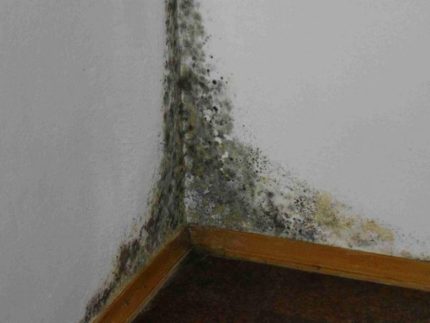
The most common causes of increased humidity are:
- Low quality insulation of the foundation with the wall.
- The presence of leaks in the pipes located in the basement.
- Inadequate ventilation. Often it happens that the ventilation in the apartment is either poorly debugged or absent a priori. Most often, the residents themselves interfere with normal ventilation, wallpapering the ventilation holes. In addition, it is unsafe and prohibited by housing and communal services regulations.
- Unscrupulous neighbors or a leaky roof.And if in the latter case you can at least see the traces of water smudges, then the intrigues of the neighbors from above can be physically unnoticed - unless, of course, a full flood happened. The thing is that water does not always leak through the ceiling and penetrates the apartment located on the floor below. Small portions are absorbed by the overlap. Or it may not be let through by a suspended plastic ceiling. It is these situations that create increased humidity with all the consequences that come from here.
- The presence of poorly repairedinterwall seams. If violations were made during the repair work, including the finishing and plastering of the walls, the normal humidity will not have to be expected.
- Basement flooding. The reason for this can be not only a burst pipe, but also the usual flooding by melt water. It is enough that for several months the water stood in the basement, and a fungus appears on the first floors.
- Failure of a wall-mounted pipe. An accident of such a plan is a great danger to the whole house, because the damp will not only be in the apartment where the leak formed, but in everyone else. The current situation is also problematic in that access to such pipes is difficult - they are inside the ducts, and it will not work to quickly determine the location of the leak.
- Incorrect installation of any equipment, one way or another connected with water. A constantly flowing tap or even a commonplace condensation on the toilet bowl - all these things will cause dampness.
Defects causing high humidity are hidden in the first stages of construction. And, if in the case of private households everything can be fixed, then apartment owners have to deal with it more difficult.
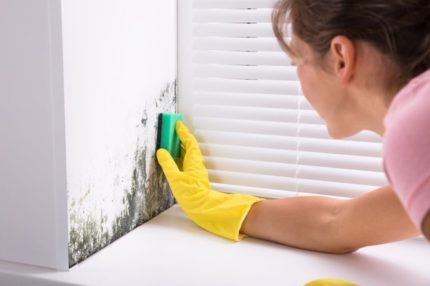
Developers very often make serious mistakes, forcing apartment owners, thus constantly struggling with high humidity and its consequences. Moreover, a long stay in such a room can adversely affect the health of all households.
The most common diseases that occur in people who have been in an apartment with high humidity for a long time are bronchial asthma, tuberculosis and aspergillosis.
The idea is that the management company should deal with this kind of problems, but not all of them conscientiously relate to their obligations.
There is one effective way to identify the source of penetration of excess moisture. Take an even glass and lean it against the wall. Tight. After a couple of days, remove the glass.
If there is moisture on the surface of the wall to which it was leaned after removal, it means it enters the apartment from the street. If the surface remained dry under the glass, it is necessary to look for a source of dampness in the walls of the apartment.
We also recommend that you read our other article, where we spoke in detail aboutair humidity on human health.
Effective Ways to Reduce Humidity
And yet, the problem of high humidity in the apartment is solved. Below are considered in detail several ways to deal with it, which will not be difficult to implement. To achieve the desired result, it makes sense to simultaneously use several of them.
In order to make sure that the humidity in the room is exceeded, we suggest using following devices.
Option number 1 - airing the apartment
The proposed method of air drying is simple and affordable, but it is quite effective. Please note that you need to ventilate the room only in dry and windy weather - otherwise the event loses all meaning.
It is especially important to carry out ventilation after cooking, taking water procedures, washing or spring cleaning, accompanied by use washing vacuum cleaner.

An interesting point about how to reduce the humidity level in the apartment in the summer, spring and winter. Everything is very simple - to solve the problem, if the humidity is increased, but not much, a powerful fan is suitable.
Using this device, you can dry the air in the room - it is not always possible to ventilate it.
Option No. 2 - heaters and dehumidifiers
If the humidity indicators in the room exceed all permissible limits and dampness is constantly felt, you will have to think about buying household dehumidifiers. Unlike industrial appliances, these are compact and operate silently. And they should not work constantly - for a successful fight against humidity it will be enough to turn on the device 2-3 times a week.
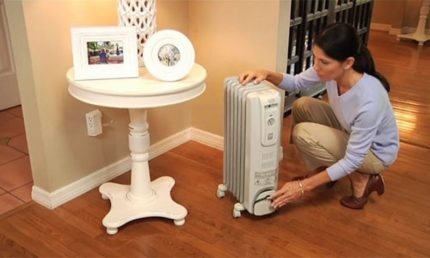
In the cold season and in early spring they are perfectly saved from damp heaters. The heat generated by them substantially dries the air - but here you need to be careful, because there is a risk of overdrying it.
In order not to overdo it in the fight against high humidity, do not use heaters during the heating season.
Option number 3 - modern finishing materials
Would you like to provide protection against dampness for a long time? Get ready for a major overhaul.
The use of non-natural materials contributes to the increase in humidity in the apartment, so it makes sense to avoid using plastic and other types of finishes that delay moisture.
Carrying out the "drain" repair involves the following measures:
- Removing the remains of the previous finish.
- Elimination, if possible, of a source of increased dampness.
- Using a heat gun - this allows you to very well dry the walls.
- Diligentlyseal all possible sources of high humidity. First of all, you need to pay attention to the joints of the walls and floor joints. To this end, the slots are poured with cement mortar and treated twice hydro- andbioprotective compounds. The most commonly used silicone sealants.
- Walls need to be treated with a water-repellent primer or bioprotection. The ideal option is to use both means.
- Prepared room must be finishedmoisture resistant drywall - one that has a green tint. Sheet thickness drywall It is about 10-12 mm.
For interior decoration of a damp homenon-woven vinyl coated wallpaper. Such a coating effectively resists moisture.
Moreover, when cleaning non-woven Wallpaper can be wiped with a damp cloth. If you do not want to usenon-woven Wallpaper, CD Wallpaper.
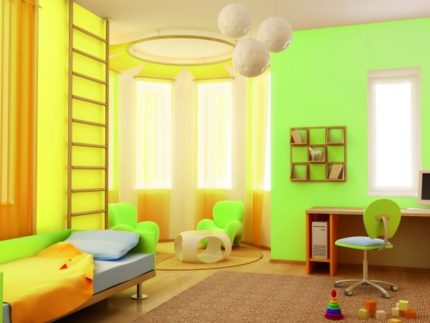
Acrylic paint and putty is a combination ideal for processing walls in a room with high humidity. Acrylic itself has a high water resistanceand mixed with putty, it provides a reliable water-repellent film.
Another suitable decor for wet rooms is ceramic tile.But its high price limits the scope, therefore, in the vast majority of cases, the scope of its use is limited to the kitchen and bathroom.
Although, if the means allow, you can tile the living rooms, only the tiles themselves should be larger than those that were used to prevent the increase in humidity in the rooms mentioned above.
Option No. 4 - tablets from dampness
An effective remedy is special absorbent tablets. For instance, Ceresit «Stop Moisture",Henkel «Stop Humidity". They are used in conjunction with a desiccant - a tank where the saline solution formed from absorbed moisture flows. The proposed tool can absorb about 0.4 liters of water per month.
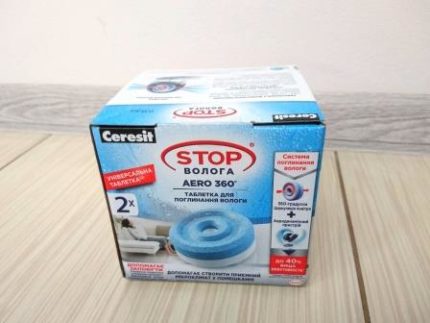
Please note that the area of the room in which the absorbent tablet is used cannot be more than 20 square meters. m. 1 tablet can be used within 2-3 months.
Option number 5 - folk remedies
If the humidity in your apartment is slightly exceeded and the dampness is not really felt, at least it does not lead to fungus.
Or the problem is acute, and you need to solve it urgently, but at the moment you do not have the amount sufficient to begin a full repair, you can try to deal with high humidity in the room with folk remedies.
Absorbent Products
Proven absorbent foods are:
- salt;
- sugar;
- rice groats;
- coffee beans.
Clear business that it is not necessary to put bags of salt, rice or sugar directly in the middle of rooms. It is quite enough to pour the above products into small containers and place them in inconspicuous places - under the bed, on the chest of drawers, etc.

It should be remembered that the use of sugar in quality moisture absorbing funds are fraught with attracting unwanted neighbors into your home - all kinds of insects like cockroaches, ants, etc., which are much more difficult to deal with than with high humidity.
Therefore, it is better to use any other products as absorbents of natural origin. By the way, with the help of coffee beans you can make a beautiful decorative composition in glass more often - for this it will be enough to add other bright components there.
The use of silica gel
Silica gel is a composition, bags with which can be found in many industrial products made of genuine leather (shoes, bags, wallets). The compound absorbs moisture perfectly. The only thing is that to reduce the humidity in the room the amount of silica gel that you get with shoes and other leather products will obviously not be enough.
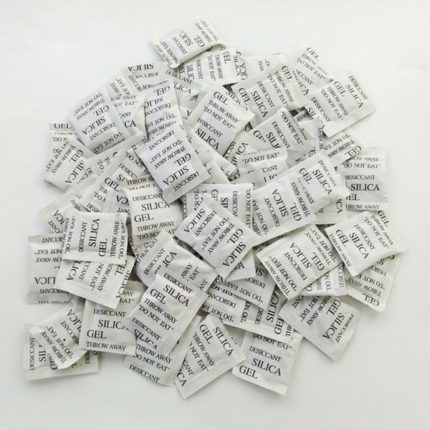
You can buy absorbent material at a pet store - there silica gel is sold as a component for a cat's toilet. When working with silica gel, be extremely careful: small children should never have access to silica gel balls, wishing to try everything “on the tooth”.
The ideal option is to use silica gel not in bulk, but to lay out fabric bags filled with this material.
Calcium Chloride, Coal and Quicklime
If high humidity is observed exclusively in non-residential premises of your apartment - pantry, vestibule, balcony, then it is permissible to use the substances listed above as absorbents.But in no case can they be used to reduce the humidity of the residential premises - this can cause a sharp deterioration in the health of households.
The principle of using the above substances as absorbents is extremely simple. Calcium chloride, charcoal and quicklime are poured into containers, previously placed in the corners of a damp room.
That's all, nothing else is needed - in six months the composition of the containers will need to be replaced, because the substance will be saturated with moisture to the limit.
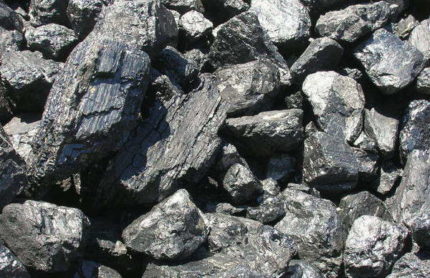
The safest option, suitable for reducing humidity in living rooms, is coal. However, care must be taken to ensure that it does not become a source of coal dust: this will adversely affect the health of households.
Choose only large chunks of coal and in no case put coal in the passage places. Lime is suitable for reducing humidity on a loggia / glazed balcony. If you are planning to use calcium chloride as an inexpensive absorbent, do not forget to dry it carefully in the oven before use, and then grind it.
Indoor humidity control flowers
Many do not even realize that some plants absorb moisture efficiently, so indoor flowers can be used to solve the problem with increased dampness!
So, if you wish, you can combine business with pleasure - having got indoor flowers that absorb excess moisture from the air. Please note that not all plants are able to effectively absorb moisture.
Absorbents of natural origin include:
- geranium;
- spathiphyllum;
- fern;
- myrtle;
- lemon;
- a coffee tree;
- laurel noble;
- syngony.
At home, only geranium can be grown. Because all the other plants listed above need abundant watering.
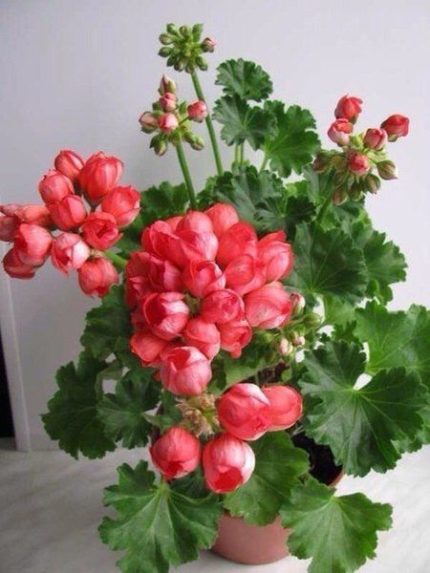
Accordingly, they themselves can easily become a source of dampness and even the appearance of mold in the room. Especially if there are several flower pots on one windowsill.
Anti-damp recommendations
Drying the air in the apartment is very important even if dampness and high humidity alone do not bother you.
The fact is that these conditions contribute to the occurrence of mold - dangerous fungi, whose vital activity can cause serious illness in humans, as well as provoke damage to property and materials used to decorate the room.

If you missed a moment and are already struggling not only with the increased level of moisture in the apartment, but also with the consequences of this phenomenon.
Or are thinking about taking preventive measures aimed at preventing moisture increase, it makes sense to follow the tips listed below:
- do everything possible to identify the reasons explaining the increased humidity and try to eliminate them. Otherwise, the fight against increased dampness will be permanent;
- be sure to ventilate the rooms after any manipulations, one way or another related to the abundant use of water - this is true in relation to washing, cooking, and also in relation to hygiene procedures.
- if there is no desire to keep the windows open for a long time in winter, and indeed this, by and large, is not particularly necessary - getting snow into the house will not bring a decrease in humidity,it is easiest to apply the tactics of “extreme ventilation - open the windows completely, but only for 2-3 minutes;
- install the hood and use it daily - at least 30-40 minutes, even if you do not cook food;
- systematically heat the house in the cold season - at least until the central heating is turned on. Remember: saving on heating is fraught with the appearance of a fungus and the need to fight it. Believe me, it is better to dry the air a little than to allow an increase in humidity;
Use plastic double-glazed windows with built-in ventilation - absolute tightness causes a significant oversaturation of the room with moisture.

The use of an air conditioner with the function of air purification, as well as the function of regulating humidity, will also help.
Conclusions and useful video on the topic
How to get rid of humidity in the room using a moisture absorber:
The humidity level in the room will be discussed in the following video:
Not so dangerous is the increase in humidity in itself, as the consequences with which it is fraught - a constant feeling of dampness, the appearance of a fungus, the incidence of households and other, very unpleasant things. Only an integrated approach to solving the problem allows us to normalize the humidity in the apartment.
Did you have problems with high humidity in the living room and how did you manage to cope with them? Please share your experience with our readers. The communication unit is located under the article.

 How much does it cost to connect gas to a private house: the price of organizing gas supply
How much does it cost to connect gas to a private house: the price of organizing gas supply  The best washing machines with dryer: model rating and customer tips
The best washing machines with dryer: model rating and customer tips  What is the color temperature of light and the nuances of choosing the temperature of the lamps to suit your needs
What is the color temperature of light and the nuances of choosing the temperature of the lamps to suit your needs  Replacement of a geyser in an apartment: replacement paperwork + basic norms and requirements
Replacement of a geyser in an apartment: replacement paperwork + basic norms and requirements